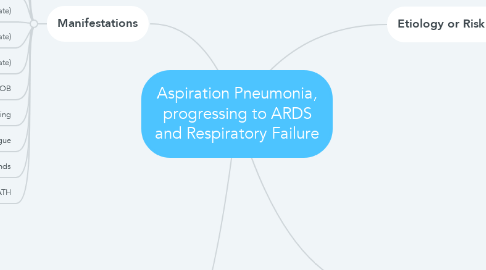Aspiration Pneumonia, progressing to ARDS and Respiratory Failure
by Courtney Leann

1. Manifestations
1.1. Dyspnea
1.2. tachypnea
1.3. restlessness
1.4. anxiety
1.5. rales and crackles on ausculation
1.6. productive/unproductive cough
1.7. cyanosis(late)
1.8. respiratory/metabolic acidosis(late)
1.9. respiratory failure (late)
1.10. SOB
1.11. wheezing
1.12. fatigue
1.13. absent breath sounds
1.14. DEATH
2. Nursing considerations
2.1. elevate HOB
2.2. maintain good dental hygeine
2.3. stop smoking
2.4. mechanical ventiltion for ARF
2.5. monitor blood chemistry and fluid levels
2.6. monitor perfusion, positioning, protect lung ventilation, protocol for weaning, prevent complications
2.7. provide adequate oxygenation
3. Etiology or Risk Factors
3.1. impaired conciousness
3.2. dental problems
3.3. sputum suctioning
3.4. dehydration
3.5. CVA
3.6. reflux esophagitis
3.7. dysphagia
3.8. existing lung condition
3.9. dementia
3.10. tracheoesophageal fistula
4. Pathophysiology
4.1. Aspiration of colonized secretions from the oropharynx is the primary mechanism by which bacteria gain entrance to the lungs.” The aspirated materials become the breeding ground for bacterial growth. Additionally, children neurologically compromised or have chronic lung disease are at an increased risk of developing aspiration pneumonia due to the insufficiency or failure of the protective reflexes that prevent food or foreign substances from entering the lungs. The severity of the injury to the lung(s) following an episode of aspiration pneumonia is usually determined by the volume and pH of the substance aspirated as well as the presence of pathogenic bacteria in the lung tissue. Patients most at risk are those who have swallowing dysfunction, gastroesophageal reflux, neurologic disease, or mechanical and device-related impairment of the upper digestive tract.


